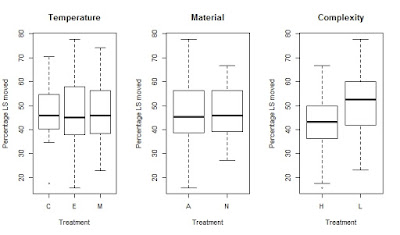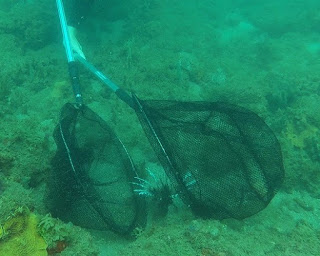The summer is officially over, and so the time has come to sit my behind on a hard seat and start typing out what actually happened during my stay in Honduras. Since I arrived back home, I went through a few days of wondering whether the trip was all a coma induced dream, but fortunately the tan proves otherwise! Which means, I have some serious writing to do... During the summer we gathered lots of data, and row after row of an excel sheet was filled with test diameter measurements, weights, temperatures, and of course, numbers indicating how many long spines had moved. Before heading back home I had stared through 133 five-minute videos of urchins being spooked out of their spines, in slow motion, silently wishing I was some software developer so I could make a program to track the movement of the spines on a video (hint hint!) and count how many moved and to what extent.
 |
| Life is made for living! |
Just to recap from an earlier post, we were looking at how changing temperature might affect the predator avoidance response (PAR) of the urchins, which in its simplest form is described as the movement of the longest spines in response to a shadow. The shadow for a simple organism like the urchin could mean there is a predator around, and the toxin filled spines are designed to deter any hungry wanderers. We also included two other factors that could have an effect on the response: reef material and reef complexity. We used concrete breeze blocks as artificial reef material and collected broken off reef rubble directly from the urchin collection site for a natural effect, assembled as either low complexity with no hiding spots or as high complexity with a shelter. Now, you might wonder why we used changing temperatures and how are reef material and complexity relevant to anything, really. All across the worlds oceans, the sea surface temperatures (SST) are changing with global warming, and in some parts of the world like around the Central American countries and down the west coast of South America, El Nino events can cause dramatic changes in the temperature by increasing the SST by up to 4 degrees Celcius. It doesn't sound like much, but consider yourself for a moment; your normal body temperature is around 36.6 degrees, and if you go even two degrees above that you are most definitely sick. And if you go up to 40 degrees, your body functions start to fail and it is vital you get your temperature down. Now, most primitive animals such as urchins do not have a system for regulating their own body temperature, and they rely on a their environmental temperature to remain relatively stable to allow for their metabolic processes to function normally. We tried to understand how, if at all, the increases in water temperature might affect one of their most vital survival mechanisms, the PAR.
 |
| Elkhorn coral, Acropora palmata, provides shelter for a multitude of fish, while increasing the complexity of the reefs. |
Loss of reef complexity is another issue faced by most coral reefs around the globe. Overfishing, extensive tourism, bleaching events and diseases, they all contribute towards flattening the reefs and killing off complex corals. As an example, the elkhorn coral Acropora palmata is a branching coral that provides shelter for juvenile fish and urchins alike, and it has been on the decline in the Caribbean for decades. People have tried artificial reefs as a solution to increase complexity and to provide corals some substrate to settle on. On Banco Capiro, which is the reef we used for this study, the density of urchins in depths below 10 meters is higher than anywhere else in the Caribbean, and this could be due to it being one of the healthiest systems around, with high complexity and a protected status that prevents fishing and other damaging activities. However, it is impossible to tell whether it is the presence of the complex corals that allows the urchins to thrive, or if the urchins clearing out settling ground gives the corals a competitive edge over the algae. Most likely, it has been a combination of a lucky location and good timing, sprinkled with a fortunate twist of fate, that has made this particular reef so successful. This is why testing for effects of reef material along with the complexity level was an important part of our research, as it can help give guidance for developing reef conservation management plans.
 |
| A low complexity artificial environment. |
 |
| A natural high complexity a.k.a. Casa de Sanni |
Now, to the results. So far, I have 8 replicates of each of the "treatments" we used for this study, making it a total of 120 data points contributing towards the data analysis. I have gone through an initial, rudimentary analysis of the data, and as of yet the only significant result I have is to do with complexity. There is an increase in the amount of spines moved in response to the shadow when the urchins were in a low complexity environment, and it means the urchins would spend a lot more energy fending off predators if there was nowhere to hide, and thus taking away time that could be spent foraging. It makes sense, of course, and I'm going to use a human example again: If you were in a forest in a bikini, being eaten by mosquitoes, you would be using up a lot of your energy swatting them off, rather than focusing on finding the tasty blueberries. It would take far longer to get enough for a pie, than if you were wearing long pants and a jumper!
 |
| Complexity between High and Low treatments shows a significant difference in the amount of long spines moved in response to the shadow stimulus. |
I have another 2 replicates of each treatment to analyse, and then I have planned to do another run through all of the videos in a randomised order to double check that my results hold. There is a lot of work to be done yet, with writing up 30-50 pages of thesis, but I have a good head start to the gang who will be doing their projects in uni this year, as I have most of my methods written up, my initial results, and they haven't even started yet! But despite having the urge to sit back and relax, I am determined to get this done in good time before Christmas exams, just so that I can enjoy the holidays ;)













































